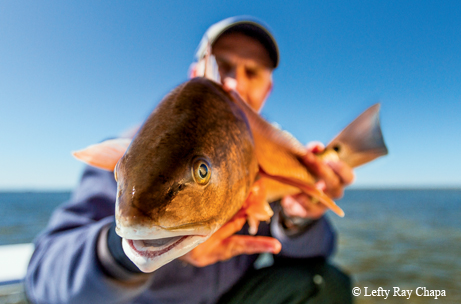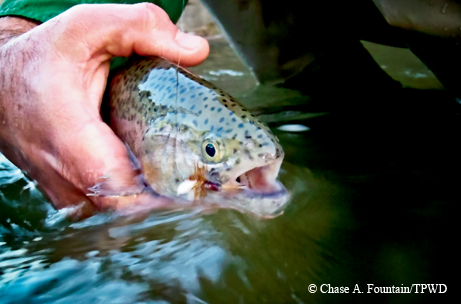
Shaking Hands With a Fish
The unexpected wonders of fly-fishing.
By Reid Wittliff
When I’m about to go fly-fishing, I become anxious and clumsy. I’m keyed up not only because of the prospect of catching fish, but also because, if experience holds true, I stand a good chance of seeing or experiencing something completely unexpected.
I begin to fish the same way every time. I take the end of my line and bend it into a loop. I then thread the loop through the guides on the rod. This way, if the line should slip, it will catch before falling back through the guides to the ground. This is a handy trick because I almost always fumble the line.
When I am finally rigged, I peel line off the reel and flick it through the guides so I have enough slack to cast. Then, I find a fishy-looking spot and begin the whoosh-whoosh of the cast. As the line flies out over the water, I intently watch the spot. The fly I have cast is connected to filament-thin tippet, then leader, then fly-line and ultimately to me via my left hand. I can make the fly come alive by stripping in some of the line or by adding slack to make the fly appear completely untethered.
If I do it all well, the fly will seem edible and easy to catch. When the take comes, even when I am expecting it, the impact of the fish on my line electrifies me. Every time. This direct connection of fish to line to angler is one of the things I love most about fly-fishing.
“It’s like shaking hands with a fish,” as a buddy once described it.

There are other, deeper things to love about fly-fishing, too. For me, those things are less about the fishing and more about the things that happen when fishing. Time and again, fly-fishing has given me the chance to experience unexpected wonders and share delight in them with those I love.
One such thing happened when I was fly-fishing with close friends on the gin-clear white sand flats of the Lower Laguna Madre. We were on a tiny skiff, poling across the skinny waters of the flat looking for redfish and speckled trout. We had worked all day to find fish and covered miles of water. We found only a few and caught not a one.
It was late afternoon, and the glare from the sharp angle of the sun made spotting fish almost impossible. We were tired and ready to call it a day. Suddenly, our guide said, “Fish! Fish, fish, fish!” We looked where he pointed. There — where just a moment before there was nothing — were a hundred or more redfish tails swaying back and forth like tiny sails in a gentle breeze. The tails rose out of the water as the fish searched for food on a circular patch of sparse seagrass about the size of a helicopter landing pad on the otherwise barren flat. As suddenly as the tails appeared, they vanished, all at the same time as if on cue.
We watched as the fish glided past the skiff just out of casting range.
To our surprise, the tails came out of the water over another patch of seagrass to our right. Like before, the tails emerged in perfect unison. The redfish then proceeded to march across the flat, tailing on one seagrass bed after another. Each time, tails popped out of the water at exactly the same moment and then, after a minute or two, went down together as if some piscatorial drum major directed the whole show. It was a magical, shivers-up-the-spine thing to see.
For a time, we just stood silently on the skiff and watched. Then, we slid off the boat and began shaking hands with one fish after another. It was the fastest redfish action I have ever experienced.
As good and fun as the fishing was, the parade of tails is what sticks with me as truly special.

Fly-fishing for redfish on the Texas coast can bring fast action.
Before I graduated to saltwater fly-fishing, I learned to fly-fish for bass. My main instruction came from a video by Dave Whitlock called Fly-fishing for Bass. In it, Whitlock catches one whopper bass after another. As a “newbie” fly-fisher, I watched it dozens of times. My goal was to catch a big bass just like Whitlock did.
I spent one whole summer trying to do so on a tiny stock pond about 15 miles from my hometown. One edge of this pond was tree-lined, and one branch of these trees stretched way out from the bank, creating a nice shady patch of water.
Fish liked the cool water in the shade, but the branch made it tricky to get a fly into that spot of water. Whitlock had a solution for this problem — the underhand cast. To do it, you cast your loop below your rod, instead of above it as usual. I never learned to do it effectively, but I did learn to do a side-armed version well enough to occasionally deliver a fly to that patch of water without getting hung up in the trees.
My usual tactic was to side-arm black wooly buggers under the branch near the bank and slowly strip them back. I hooked and caught a lot of perch this way — and also lost a lot of wooly buggers in the branch. But I never found the big bass I was hoping for. Not until late one summer afternoon when I was fishing with my dad.
As the sun started to fade, he paddled me to the shady spot for a final few casts. For some reason, I tied on a big green-and-orange, frog-like popping bug instead of my usual wooly bugger. I side-armed the bug under the branch and let it sit. Then, ever so gently, I stripped the line just enough to make the frog’s rubber legs jiggle. Like a ballistic missile fired from the depths of the ocean, the biggest bass I had seen on that pond exploded out of the water. He flew straight up, rolled over at the top of his leap, and with jaws spread wide fell back to the water, engulfing the frog on re-entry.
I froze. Never had I seen a fish take a fly on the way back into the water. Dad yelled at me to set the hook, and I tried. It felt as though my line was connected to a solid brick wall — but only for the briefest of instants. Then my line, sans frog and sans bass, came careening back toward me.
A wave of disappointment washed over me. Whitlock’s video had a long segment on the hook-set. I had muffed the whole thing up. I looked back at my dad. He didn’t look frustrated. Instead, he had a huge grin on his face. I started to grin, too, and my disappointment evaporated. Neither of us could explain why that bass took the fly on the way back into the water. That was just “bassackwards,” my dad said.

The Guadalupe River below Canyon Lake offers a special treat for Texas anglers: the opportunity to fly-fish for trout.
Perhaps my most cherished memory of a fishing surprise came about on a New Mexico trout stream. For a time during my teenage years, my dad and I and a dear family friend (whom I called Uncle John) took an annual trip to fly-fish for trout on this river. We fished with a particularly persnickety guide who was a committed fly-fishing purist.
This river produced big fish and in good numbers, but generally we had to use nymphs or other sub-surface flies to catch them. We relished the few times we found dry-fly action — it is much more exciting to see a trout rise and take a fly off the surface than to feel an unseen one tug your line.
Prior to these trips, Uncle John spent weeks tying flies so that he had boxes of them at the ready. Sometimes he made up entirely new patterns. This particular year, Uncle John had invented a new version of one of our go-to dry flies, the Griffith’s Gnat.
The Griffith’s Gnat is a tiny fly that looks more like a speck of fuzz than any insect a trout might want to eat. It is meant to replicate groups of 10 or 20 gnats that sometimes cluster together on the water. When there are sufficient numbers of these clusters, trout will rise and gently suck them in.
The version Uncle John created was not anything like the original. His version was about 20 times bigger and more closely resembled a pad of hair scraped from a shower drain than an actual Griffith’s Gnat. We gave Uncle John a good dose of ribbing when he showed it to us.
We caught a lot of trout on this trip, including some big fish. But until the last afternoon, all our fishing had been with nymphs. We were lined up in the middle of the river nymphing when our guide called us together and pointed to the far riverbank. We saw a series of rising trout lined up along a seam in the current. The way they were softly tipping their noses out of the water indicated they were sipping gnats from the surface. Dry fly time.
Our guide — ever the purist — insisted that we tie on 15-foot leaders and wisp-thin tippets. He then had us slowly creep to within casting distance of the rising trout. He pulled three Griffith’s Gnats from his fly box and gave them to us. In a hushed voice, he instructed us to cast above the spot we last saw a fish rise and to not make more than one false cast, so as not to spook the fish.

Fly-fishing requires skill and artistry and draws on a rich tradition. This rainbow trout was caught in the Guadalupe River.
My first cast was perfect. The Griffith’s Gnat floated a line that drifted directly where I had last seen a trout rise. But there was no take. I tried again. And then again, but nothing. I moved to another rising fish but could not raise him to my fly.
The guide, Uncle John and I began working together. One of us would cast, and the guide would instruct us on when to mend the line to keep the fly floating drag-free. We tried timing our casts so that the fly would be just above the fish when, based on his pattern, he should be rising. Nothing worked.
Finally, I turned to Uncle John and asked for his cluster fly. Uncle John gave me one as the guide tried to convince me otherwise. I began to tie it on anyway. The guide sighed and waded upstream to help my dad.
I cast the gargantuan fly to the same spot where I had cast the Griffith’s Gnat. The cast was good, and the big fly lumbered down the feeding lane toward the rising trout. Just before it arrived at the spot where the fish should be, a big green snout poked out of the water. Uncle John and I held our breaths and tensed, but the trout did not eat the fly. I tried the same cast again. This time, when the fly reached the spot, the trout slammed it. I raised my rod and it was hooked.
A few minutes later, Uncle John netted the fish for me. I pulled his fly from the fish’s lip and held it high for my dad and the guide to see. Uncle John and I laughed and laughed and laughed.
“A triumph,” Uncle John said. “That’s just a triumph.”
And it was. Not just because we caught that trout on that fly, but because we were there to experience all of it together.

